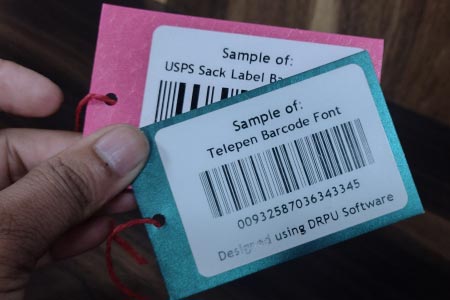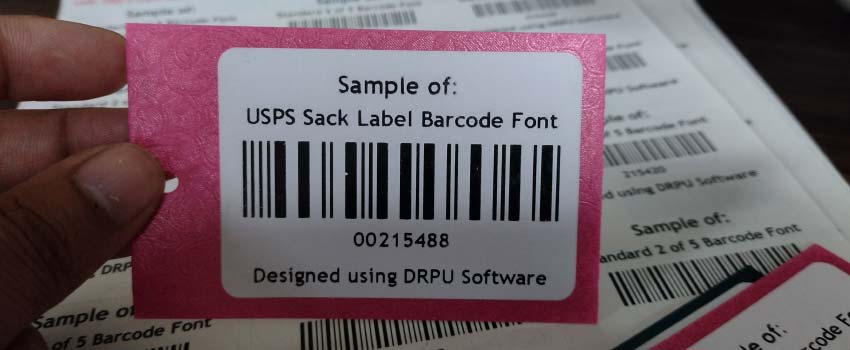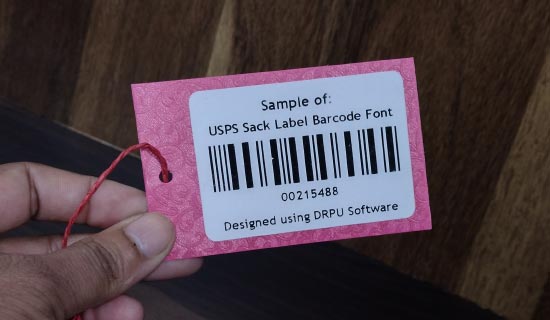The USPS sack label barcode is a 4-state barcode that encodes a unique identifier for the mail sack, allowing it to be tracked and sorted automatically by postal processing equipment. These barcodes are applied to the outside of sacks containing large volumes of mail, such as bulk mailings from businesses or organizations. The barcode is printed on a label that is affixed to the outside of the mail sack, and it contains both human-readable text and a machine-readable barcode.
⮊ The format of the USPS sack label barcode is specified by the USPS in their Publication 199: Intelligent Mail Package Barcode (IMpb) Implementation Guide. The barcode consists of a 20-digit unique identifier called the Mailer ID (MID) followed by a 9-digit serial number. The barcode is printed in a 7-bit binary format using four different types of bars and spaces, each with a different width and height.
⮊ The USPS sack label barcode is a 4-state barcode that encodes a unique identifier for the mail sack, allowing it to be tracked and sorted automatically by postal processing equipment. The barcode is printed on a label that is affixed to the outside of the mail sack, and it contains both human-readable text and a machine-readable barcode.
⮊ The USPS sack label barcode is typically generated by a mailer or shipping software system that has been certified by the USPS for use with their Intelligent Mail Package Barcode (IMpb) program. The software generates the barcode and prints it on a label that is then affixed to the mail sack. The mailer is responsible for ensuring that the barcode is printed correctly and that the label is securely attached to the sack.
USPS Sack Label Barcode Different From Other Barcode Types

The USPS sack label barcode is a specific type of barcode used by the United States Postal Service (USPS) to track and sort mail sacks. While it shares some similarities with other barcode types, such as the Universal Product Code (UPC) and Code 39, there are several key differences that set it apart.
Once the mail sack is in the postal system, the USPS uses automated processing equipment to read the barcode and track the location and status of the mail sack. The barcode is read by scanners at various points in the processing and delivery cycle, allowing the USPS to track the progress of the mail sack and ensure that it is delivered to the correct destination.
These differences include the barcode structure, data encoding, and the specific applications for which it is used. In this answer, we will explore how the USPS sack label barcode differs from other barcode types in greater detail.
In addition to providing tracking and sorting information, the USPS sack label barcode can also be used to generate reports and provide data to mailers about the delivery status and performance of their mailings. This information can be used to help mailers optimize their mailing processes and improve the effectiveness of their marketing campaigns.
-
Barcode Structure:
The structure of the USPS sack label barcode is unique and different from other barcode types. The barcode consists of a series of vertical bars and spaces, with a unique identifier encoded within the barcode. The barcode is printed on a label that is affixed to the outside of a mail sack, allowing the USPS to track and sort the sack as it moves through the mail processing system.
-
Data Encoding:
The data encoding used in the USPS sack label barcode is also unique. The barcode encodes a 31-digit alphanumeric code that includes information about the origin, destination, and contents of the mail sack. This data is encoded using a modified version of Code 128 symbology, which allows for the inclusion of alphanumeric characters in addition to numeric digits.
📝 In conclusion, the USPS sack label barcode is a type of 4-state barcode used by the USPS to track and process mail sacks as they move through the postal system. The barcode encodes a unique identifier for the mail sack and is printed on a label that is affixed to the outside of the sack. The barcode is generated by mailer or shipping software and is read by automated processing equipment at various points in the postal system to track the location and status of the mail sack.
USPS Sack Label Barcode Read and Decoded
The USPS sack label barcode is a type of linear barcode used by the United States Postal Service (USPS) to track mail sacks as they move through the postal system. The barcode is made up of a series of bars and spaces of varying widths that represent specific information about the mail sack, such as its origin, destination, and contents.
🔷 To read and decode a USPS sack label barcode, a barcode scanner or reader is required. The scanner emits a beam of light that illuminates the barcode, and then detects the reflection of the light off the barcode. The scanner then converts the reflections into electrical signals, which are sent to a computer or other device that decodes the barcode and translates the information into readable text.
↠ 0: represented by the state "space, space, bar, bar"
↠ 1: represented by the state "space, bar, space, bar"
↠ 2: represented by the state "space, bar, bar, space"
↠ 3: represented by the state "bar, space, space, bar"
🔷 The USPS sack label barcode uses a 4-state symbology, which means that each character in the barcode can be represented by one of four possible states. The four possible states are represented by two bars and two spaces of varying widths, and each state can represent one of four possible characters.
The process of reading and decoding a USPS sack label barcode involves several steps:
-
Scan the
Barcode:
The barcode scanner emits a beam of light that illuminates the barcode, and then detects the reflection of the light off the barcode.
-
Convert the
Reflection into Electrical Signals:
The scanner converts the reflections into electrical signals, which are sent to a computer or other device that decodes the barcode.
-
Decode the
Barcode:
The computer or other device reads the patterns of bars and spaces in the barcode and translates them into readable text, using the 4-state symbology described above.
-
Interpret the
Information:
The Interpret decoded information is used to track the mail sack as it moves through the postal system, ensuring that it is delivered to its intended destination.
🔷 The USPS sack label barcode can encode up to 20 characters of data, including the destination ZIP code, a unique identifier for the mail sack, and other relevant information. The barcode is typically printed on a label affixed to the outside of the mail sack, and can be read by a barcode scanner at various points in the postal system to track the movement of the sack and ensure that it arrives at its intended destination.
📝 In summary, the USPS sack label barcode is a type of linear barcode used by the USPS to track mail sacks as they move through the postal system. The barcode is read and decoded using a barcode scanner, which converts the patterns of bars and spaces into electrical signals, and a computer or other device, which translates the signals into readable text. The USPS sack label barcode can encode up to 20 characters of data and uses a 4-state symbology to represent each character.

Limitations Of Using USPS Sack Label Barcode
The United States Postal Service (USPS) uses a Sack Label Barcode (SLB) system to track and manage mail sacks. The SLB is a unique identifier that is attached to each mail sack and scanned at various points throughout its journey to its final destination. While the SLB system provides significant benefits to the USPS, it also has limitations that can impact its effectiveness. In this essay, we will explore the limitations of the USPS SLB system and how they impact its ability to track and manage mail sacks.
-
First, it is essential to understand the basic functionality of the SLB system. The SLB is a unique barcode that is attached to each mail sack. It contains information such as the origin, destination, and type of mail inside the sack. This information is critical for employees to sort and deliver mail accurately and efficiently. When a mail sack is scanned, the SLB is read, and the information is sent to the database.
-
One of the main limitations of the SLB system is its reliance on human input. USPS employees must manually attach the SLB to each mail sack, and it is not always done correctly. If the SLB is attached incorrectly or not scanned correctly, the USPS database will not have accurate information about the mail sack's location. This can lead to delays in delivery and a reduction in the system's overall efficiency.
-
Another limitation of the SLB system is its inability to track individual pieces of mail within a mail sack. While the SLB provides information about the origin, destination, and type of mail inside a sack, it does not provide information about each individual piece of mail. This can be problematic if a specific piece of mail is lost or delayed. USPS employees must manually search through the entire mail sack to find the missing mail, which can be time-consuming and inefficient.
-
The SLB system also has limitations regarding its ability to handle high volumes of mail. During peak mailing periods, such as the holiday season, the USPS processes millions of pieces of mail each day. This can put a significant strain on the SLB system, which may not be able to keep up with the volume of scans required to track each mail sack's location accurately. This can result in delays in delivery and a reduction in the system's overall efficiency.
-
Another limitation of the SLB system is its inability to track mail sacks once they leave USPS facilities. Once a mail sack is delivered to a non-USPS facility, such as a post office , the SLB system is no longer able to track its location. This can be problematic if a mail sack is lost or delayed during transit outside of USPS facilities. Without the SLB system's ability to track the sack's location, USPS employees may have difficulty locating it and delivering the mail inside.
-
Finally, the SLB system has limitations regarding its ability to provide real-time information to USPS managers. While the SLB system does provide real-time information about the location of mail sacks, it does not provide real-time information about other critical factors, such as delays in delivery or damage to mail. USPS managers must rely on manual reports from employees to track these issues, which can be time-consuming and inefficient.
📝 In conclusion, while the USPS SLB system provides significant benefits to the USPS, it also has limitations that can impact its effectiveness. The system's reliance on human input, inability to track individual pieces of mail within a mail sack, limitations regarding its ability to handle high volumes of mail, inability to track mail sacks outside of USPS facilities, and limitations regarding its ability to provide real-time information to USPS managers all contribute to these limitations.
Applications Of United States Postal Service Barcode
❖ The primary application of the USPS sack label barcode is for mail sorting and tracking within the USPS mail processing system. The barcode is used to identify and track mail sacks as they move through the processing facilities, ensuring that the mail is sorted and delivered quickly and efficiently. The barcode is also used to track packages and other types of mail sent through the USPS, providing customers with real-time tracking information about the status of their shipments.
❖ Other barcode types, such as the UPC and Code 39, are used for different applications. For example, the UPC barcode is commonly used in retail environments to track and manage inventory levels of products. The barcode is scanned at the point of sale to record the sale and update the inventory levels in real-time. Code 39, on the other hand, is a widely used barcode symbology that can encode alphanumeric characters and is commonly used in a variety of applications, including inventory management, shipping and receiving, and asset tracking.
📝 In summary, while the USPS sack label barcode shares some similarities with other barcode types, such as the use of bars and spaces to encode data, it differs in its specific structure, data encoding, and applications. The barcode is specifically designed for use within the USPS mail processing system, and its unique encoding and labeling structure enable the USPS to efficiently sort and track mail sacks as they move through the system.
